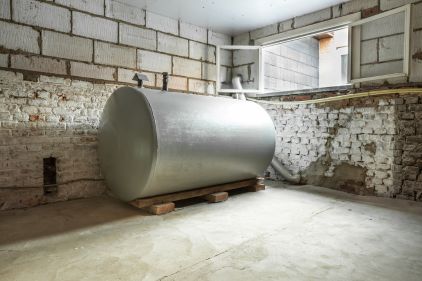
Written by Kayla Jane Barrie Updated on Nov 24, 2025 6 mins read

Did you know that if you heat your home with oil, you must inform your insurance provider? The primary heat source in your home can affect insurance coverage and costs.
CBC reported that older oil tanks can be a significant liability for homeowners due to the risks and costs associated with clean-up.
With Canadians turning up the heat for another chilly autumn and winter season, homeowners are turning on their baseboard heaters and other heating devices such as oil heaters. Proper maintenance and insurance implications are essential. In this blog, you’ll learn how oil tank heating can impact your policy and how to heat your home safely.
An oil tank for home heating is a storage container designed to hold heating oil and is used as fuel to power furnaces or boilers in homes.
The heating oil stored in the tank is burned in a furnace or boiler to produce heat, which is then distributed throughout the home via ducts, radiators, or underfloor heating systems. Oil tanks are typically made of steel, fibreglass, or a combination of materials to ensure durability and prevent leaks. They are usually equipped with gauges to monitor oil levels and valves to control oil flow to the heating system.
Heating oil is commonly used in areas where access to natural gas is limited or unavailable. Proper maintenance of oil tanks, including regular inspections and cleaning, is crucial to prevent environmental hazards such as oil spills, which can be costly. Due to the risks associated with this type of home heating, homeowners with oil tanks often need specialized coverage.
In 2023, heating a Canadian home with oil can be a costly endeavour , with average annual expenses ranging from $2,000 to $5,500 for homes consuming between 1,000 and 3,500 litres of oil per year.
This price range is influenced by factors such as location, climate, and the efficiency of heating equipment. In contrast, natural gas heating proves significantly more affordable, with average annual costs for Canadian homes ranging from $500 to $2,000.
For homeowners currently relying on oil heating, switching to an eligible heat pump system presents a compelling opportunity for substantial savings, potentially reducing annual energy bills by $1,500 to $4,500.
Most homeowner's insurance policies cover damage from an oil tank leak, but essential nuances exist. Some companies automatically include oil spill coverage, while others don't.
It's crucial to inform your insurer if your home is heated using oil. Your insurer may ask about the age and type of your oil tank and require inspection reports. Understand what is covered for damage to your home and belongings caused by the oil leak, including the cost of removing contaminated soil and cleaning up the spill.
An example of when insurance would cover an oil tank heater spill might look like this:
Sarah's oil tank developed a crack, causing a significant oil spill. Fortunately, her homeowner’s insurance policy included environmental damage coverage as part of her oil tank rider. The insurance covered cleanup, soil remediation, inspection, testing, and oil tank repair or replacement.
However, it would not cover environmental agency fines if Sarah had been negligent. Regular maintenance and oil tank inspections ensured the insurance fully honoured her claim.
Coverage providers often will not approve your home insurance claim for an oil tank heating mishap for the following reasons:
Here’s an example of when insurance would not cover an oil tank heater spill:
John lives in an older home with an oil tank heater. Over the years, he noticed that the tank showed signs of rust and wear but decided to delay any maintenance or repairs, thinking it would last a little longer. One day, the tank finally ruptured, causing oil to spill into the basement and leak into the soil beneath the foundation.
John called his insurance company, expecting the spill to be covered under his homeowner’s policy. However, after an inspection, the insurance company denied the claim, explaining that the spill was not covered due to neglecting maintenance and not being honest with their provider about the type of heating used in their home.
Oil tank heating systems can increase insurance costs in Ontario due to their higher risk. Oil tanks can lead to environmental damage, costly cleanup efforts, and a higher risk of fire or explosion. Maintaining the tank and meeting safety standards can help minimize additional costs.
Premiums for properties with oil tanks may increase by 10-20% due to the higher risk of leaks or spills. Regular inspections and maintenance can help reduce these costs. Don’t forget to compare your options for home insurance in Ontario to find a lower rate.

New oil tank prices have steadily increased in recent years, with most replacement tanks now fetching prices upwards of $5,000.
Homeowners who need to replace a damaged tank may face additional charges from their insurance companies. To illustrate, a customer recently shared that companies may demand soil samples be taken before the tank pad is poured, incurring an additional cost of around $1,000 on top of the new tank expense.
According to the Insurance Bureau of Canada, a home with an exterior oil tank older than 15 years or an interior tank older than 25 years will not be insured. However, it is essential to verify the details with your policy and insurance provider for exact information.
Some factors that can affect coverage include:
Oil tanks, particularly older construction ones, pose distinct challenges for homeowners and their insurance coverage. The potential for leaks, which can result in substantial damage to property and the environment, represents a risk that insurers scrutinize.
The concealed nature of underground tanks, where leaks may remain undetected for extended periods, contributes to the intricacy of the issue. Given the considerable cost of cleanup and remediation, this further compounds the challenge. Oil leaks can be a costly problem, so much so that real estate agents often advise homeowners to replace their tanks when selling a home.
Environmental regulations and liability considerations linked to oil spills can impose substantial financial burdens on homeowners and providers. When combined with the possibility of pre-existing leaks and negligence, oil tanks represent a source of uncertainty and potential exclusions within policies.
Here are five maintenance tips for your oil heating system to consider:
It's recommended to have your oil tank inspected at least once a year, ideally in the fall before the heating season begins. This inspection should include checking for leaks, corrosion, and proper venting. You should also have your tank cleaned every 3-5 years, depending on usage and the quality of the oil.
Oil tank heaters typically require replacement every 15 to 25 years, depending on the tank's material, maintenance, and environmental conditions. Regular inspections and servicing can help prolong their lifespan and ensure safe, efficient operation.
It's always best to be proactive and maintain your oil tank properly. Regular inspections and maintenance can help prevent leaks and ensure your coverage remains valid. Consider learning more about modern home heating options such as HVAC system upgrades and heat pumps.
| Categories | Home |
|---|---|
| Tags | Home Coverage |
Read our insurance blog to get helpful tips, information and news.
Has your car been totalled in an accident? Is your car a write off? Learn about vehicle write offs for a total loss insurance claim.
Get the facts on Toronto's auto theft problem. We break down the data, reveal the most-stolen vehicles (including the Honda CR-V and Lexus RX 350), and show which neighbourhoods are most affected.
Dive into the world of auto theft with our blog on the most stolen cars in Canada. See the most stolen cars across Canada, including provincial lists for Ontario and Quebec, and learn how high-risk models can affect your car insurance premiums.
Drive safe this winter! Check out these tips for driving in snowy and icy conditions in Ontario. Get other helpful info and FAQs on winter driving.